Colours
Distinguishing features
In spring and summer (late April or May to August), the adults are spotted black and white on the back and wings. The face and neck are black with a white border; they have a black breast and a white rump. The tail is white with black barring. The bill and legs are black.
They moult to winter plumage in mid August to early September and retain this until April; this being a fairly plain grey above, with a grey-speckled breast and white belly.
The juvenile and first-winter plumages, held by young birds from fledging until about one year old, are similar to the adult winter plumage but with the back feathers blacker with creamy white edging.
In all plumages, the inner flanks and axillary feathers at the base of the underwing are black, a feature which readily distinguishes it from the other three Pluvialis species in flight. On the ground, it can also be told from the other Pluvialis species by its larger (24–34 mm), heavier bill.
In spring and summer, during mating season, the adults' bellies of this species turn black whether the bird is still in its wintering place because it does not want to migrate, or in its breeding grounds up in the arctic of northern Canada and Alaska. (Wikipedia)
Size
- From 27 cm to 30 cm (Length of specimen)
Wingspan
- From 71 cm to 83 cm
Synonyms
Distribution
Distribution and habitat preferences
It breeds in arctic regions. It is a long-distance migrant, with a nearly worldwide coastal distribution when not breeding. In the New World they winter from southwest British Columbia and Massachusetts south to Argentina and Chile, in the western Old World from Britain and southwestern Norway south throughout coastal Africa to South Africa, and in the eastern Old World, from southern Japan south throughout coastal southern Asia and Australia, with a few reaching New Zealand. (Wikipedia)
Diet
They forage for food on beaches and tidal flats, usually by sight. The food consists of small molluscs, polychaete worms, crustaceans, and insects. (Wikipedia)
Web resources
References
- Simpson, K., N. Day and P. Trusler (2004). Field Guide to Birds of Australia: 7th Edition Penguin Group (Australia), Camberwell, Victoria.




